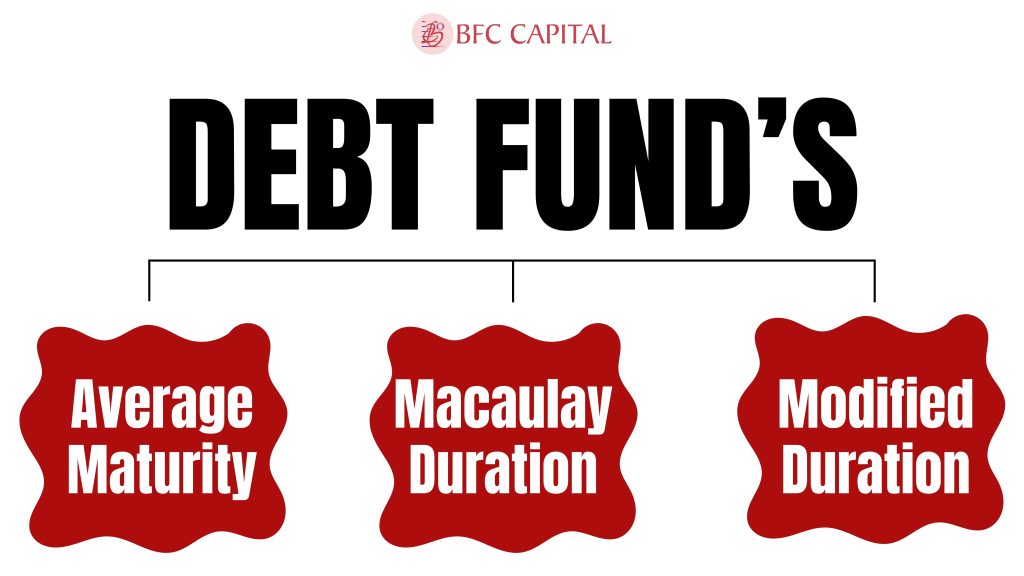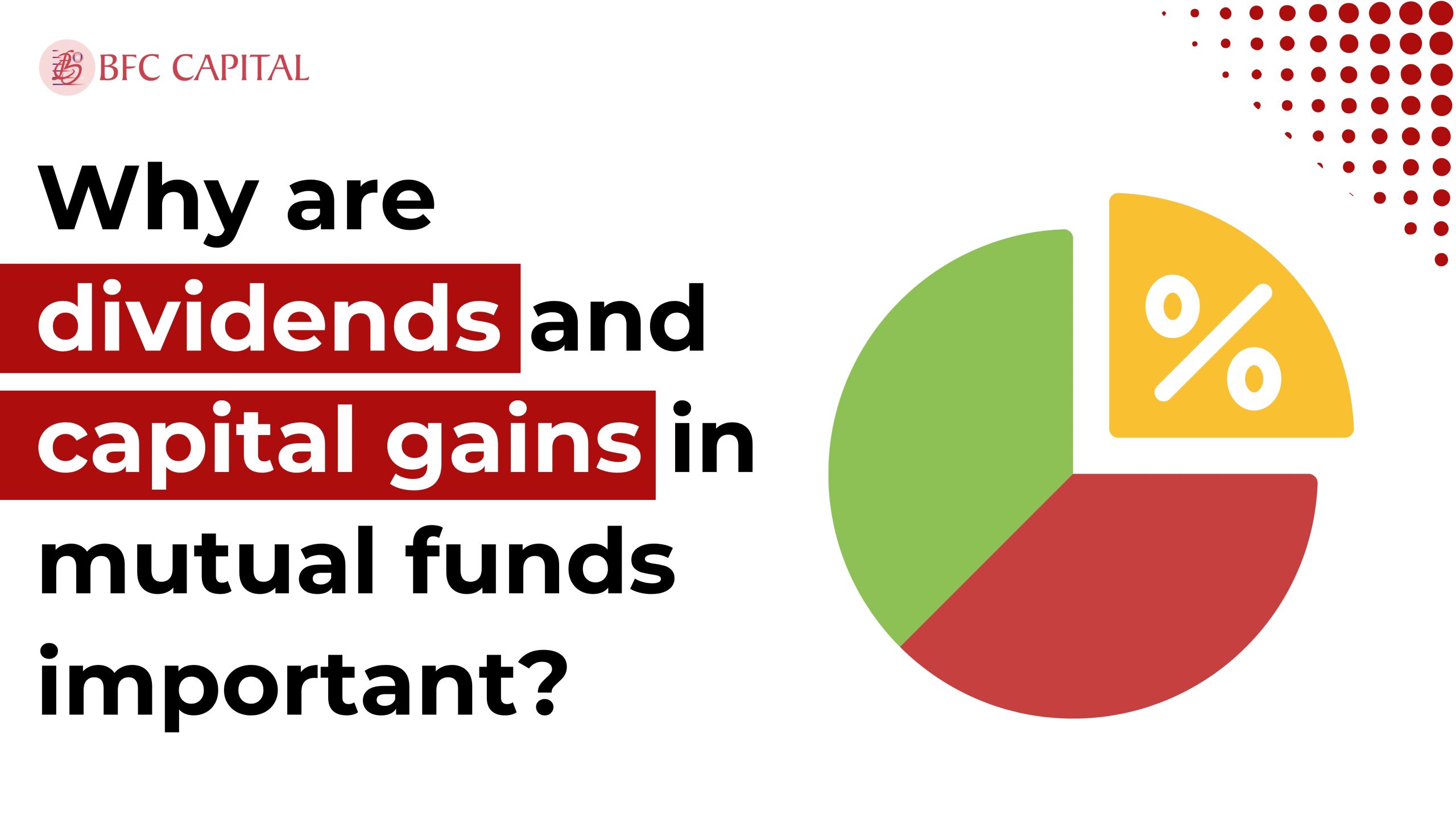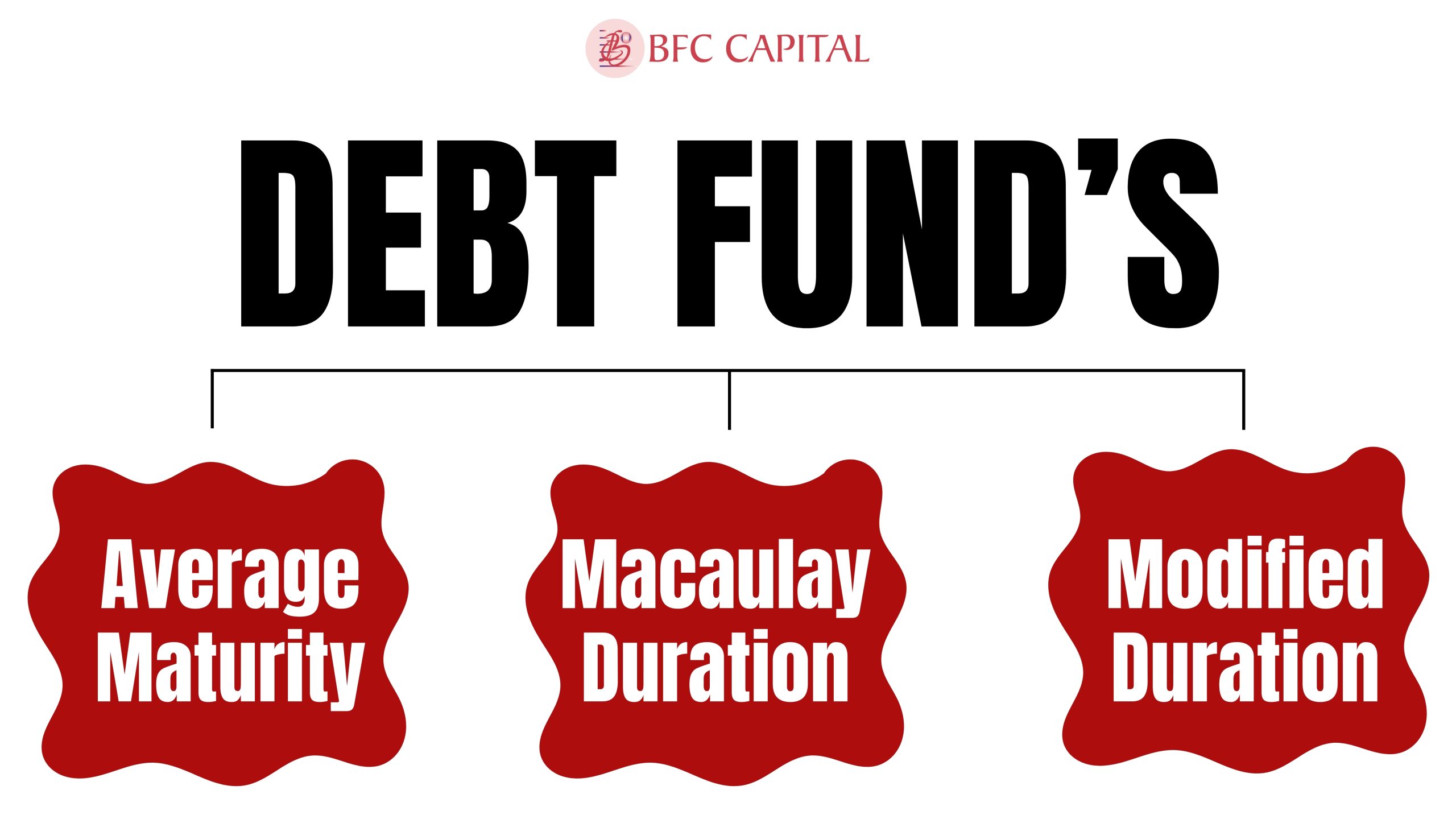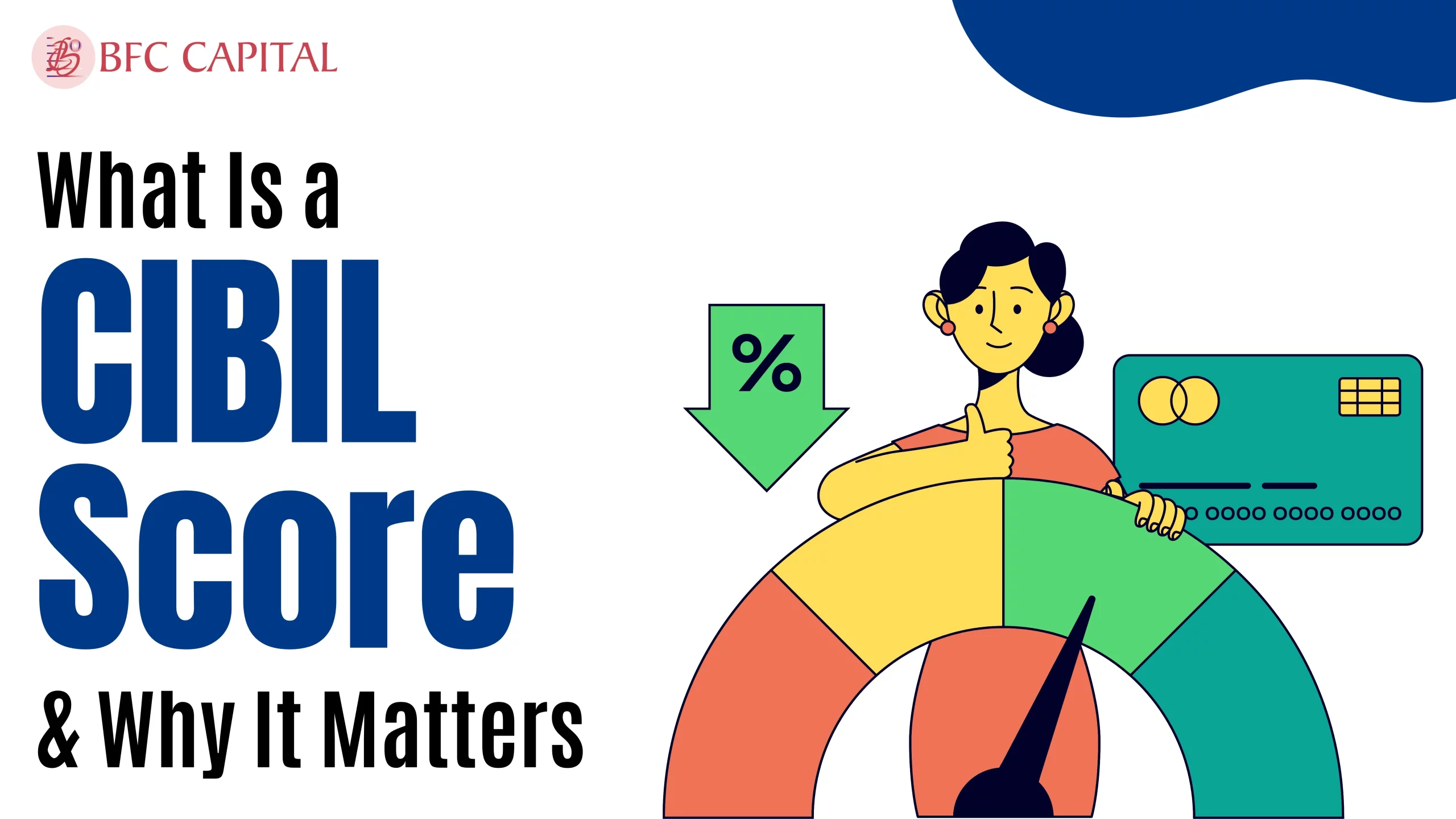
Introduction
Are you also wondering how to understand the complications of debt funds? Do you face difficulties with terms such as Average Maturity, Macaulay Duration, and Modified Duration? Then we are here for you to provide a brief idea. All of these terms may sound complicated but they are very important and effective while making an informed decision in the world of debt funds. But, how exactly do these metrics impact your investment decisions? How can knowledge about them allow you to avoid high risks and achieve high returns?
So, let us begin the quest to understand these key financial fundamentals, how they are connected, and why they are important to your investment decisions. This guide will help you shed light on the complexities of the debt funds industry, irrespective of the experience level required to invest in them.
Table of Contents
1. Average Maturity
Definition and Calculation
Average Maturity is calculated by taking out the average of the time left within a debt funds portfolio that is to mature. It is computed by taking the time of the product to maturity of each security and the weight of the security in the portfolio. At last, then finds the sum of the resultant values.
Average Maturity – Σ( Time to Maturity of Security * Market Value of Security/Total Market Value of Portfolio)
Significance
Average Maturity on a relative scale is well positioned to capture the interest rate risk and the duration risk of a debt fund. Thus, debt funds with higher average maturities usually indicate higher interest rate risk. For instance, long-term debt securities tend to show relatively larger price changes for the change in interest rates than short-term securities.
Impact on Investors
Long-term investors intending to put their money away for long-term periods could opt for debt funds with higher average maturity, thereby, the debt funds can provide higher returns because of the term structure. However, such investments are associated with higher risks of return than are the liquid investments. On the other hand, the interest rate risk might be avoided by the purchase of funds with shorter average maturity by conservative investors or those with shorter investment periods.
2. Macaulay Duration
Definition and Calculation
Macaulay’s Duration refers to the average time it takes for all the cash inflows from the bond to be collected, discounted by their respective times. It is an average of the probability that the cash flows of the bond will be received by the investor by a given time and this is done about the present value of the cash flows.
Macaulay Duration – Σ ( Present Value of Cash Flow at Time t/ Price of Bond) * t
Where:
- Present Value of Cash Flow at Time t is the cash flow divided by (1+y)t
- y is the yield to maturity
- t is the period
Significance
Macaulay duration helps in finding the degree to which the price of a bond is affected due to a change in interest rates. This is also an approximation of what it takes to receive the weighted average of the bond’s cash flows from an investor’s investment. Macaulay Duration is most applied in the immunization process where investors try to ensure that the duration of assets they hold matches the duration of the liabilities so that they can be immune against fluctuations in the rate of interest.
Impact on Investors
Macaulay duration is useful in explaining the extent of fluctuation in the price of a bond triggered by a shift in the interest rate. This is also an approximation of what is required to receive the weighted average of the bond’s cash flows from an investor’s investment. Macaulay’s concept of duration can be used more especially in the immunization process where investors attempt to make sure that the duration of assets equals the duration of liabilities to be immunized against changes in the rate of interest.
3. Modified Duration
Definition and Calculation
Macaulay’s duration is the average time to maturity with reference to the weighted average of the cash flows of the bond. Modified duration is the adjusted form of Macaulay’s duration which incorporates the yield to maturity (YTM) of the bond to measure price volatility to interest rate risk.
Modified Duration =Macaulay Duration/ [1 + (YTM/n)]
Where:
- y is the yield to maturity
- n is the number of compounding periods per year
Significance
Here we need to locate Modified Duration and the concept that it directly measures the level of change in the price of bonds resulting from a change in interest rate. Since it allows its users to assess and reduce interest-rate risk, it is an indispensable measure widely applied to the administration of the fixed-income portfolio. Modified Duration is used to establish the extent to which the bond price varies for every one per cent in the interest rates and therefore, the higher the MOD the more sensitive the bond’s price to interest rate changes.
Impact on Investors
Modified Duration helps investors predict the effects of changes in interest rate levels on the relevant bond investment. For instance, Modified Duration is equal to 5; this means that if there is a 1% upward change in interest rate, then the approximate decline in bond price would be 5%. This metric is used to build and control bond portfolios, especially during periods with sharp fluctuations in interest rates.
Interrelation and Practical Application
The concepts of Average Maturity, Macaulay Duration, and Modified Duration and the relation between them are crucial to managing and investing in debt funds.
Interrelation
- Average Maturity provides the general image of the timeframe for the debt fund’s investments to mature.
- Macaulay Duration gives the bond’s covered weights the average time to get the collection of the bond’s cash, enabling a better way to evaluate the interest rate risk.
- Modified Duration establishes the degree to which a bond’s price is affected by interest rate fluctuations and effectively offers a framework for handling interest risk.
Practical Application
These metrics are useful for independent and mutual fund managers who select the securities to invest in. For instance:
- Portfolio Immunization: Portfolio managers can hedge against fluctuation in interest rates through the matching of the Macaulay Duration of various bonds in a debt fund.
- Risk Management: Modified Duration is useful in fine-tuning the portfolio’s response to changes in interest rates by identifying appropriate bonds of required lengths.
- Performance Evaluation: The aforementioned metrics help in assessing and comparing the performance and risk characteristics of various debt funds.
Differences Between Average Maturity, Macaulay Duration, and Modified Duration
| Basics | Average Maturity | Macaulay Duration | Modified Duration |
| Definition | Average Maturity on a relative scale is well positioned to capture the interest rate risk and the duration risk of a debt fund. | It refers to the average time it takes for all the cash inflows from the bond to be collected, discounted by their respective times. | Modified Duration is the measure of Macaulay Duration with the view to showing the new coefficient of a 1% change in yields |
| Calculation Basis | It is done based on cash payables or the period of the bond’s cash flows. | It is done based on using the discounted value of each cash flow based on the time it will take to receive them. | It is done based on Macaulay Duration and modified by dividing by 1 plus the yield on the bond divided by the number of compounding periods in the year. |
| Expressed In | Years | Years | Years |
| Interest Rate Sensitivity | Not directly affected | Shows timidity but does not consider fluctuation in yield. | Quantifies the extent to which its price changes based on variations in interest rates. |
| Complexity | Simple | Moderate | More complex |
Wrapping Up
Understanding debt funds is a technical concept. You must do extensive research to know all aspects of it. Here, we have made your work easier by providing a comprehensive about Average Maturity, Macaulay Duration, and Modified Duration of Debt Funds. Therefore, you must go through it carefully and learn all information related to it.
Understanding these concepts allows investors to make sound and informed decisions and gain high interest rates when there is market fluctuation.
Please share your thoughts on this post by leaving a reply in the comments section. Also, check out our recent post on: “Balance Sheet: Meaning, Types, Components & Importance“
To learn more about mutual funds, contact us via Phone, WhatsApp, Email, or visit our Website. Additionally, you can download the Prodigy Pro app to start investing today!
Disclaimer – This article is for educational purposes only and by no means intends to substitute expert guidance. Mutual fund investments are subject to market risks. Please read the scheme related document carefully before investing.

Assistant Vice President – Research & Analysis
Akash Gupta heads the Research & Analysis department at BFC CAPITAL, where he combines in-depth market insights with strategic analysis. He holds multiple certifications, including:
- NISM-Series-XIII: Common Derivatives Certification
- NISM-Series-VIII: Equity Derivatives Certification
- NISM-Series-XXI-A: Portfolio Management Services Certification
- IRDAI Certification
With his expertise in equity, derivatives, and portfolio management, Akash plays a key role in providing research-backed strategies and actionable insights to help clients navigate the investment landscape.







